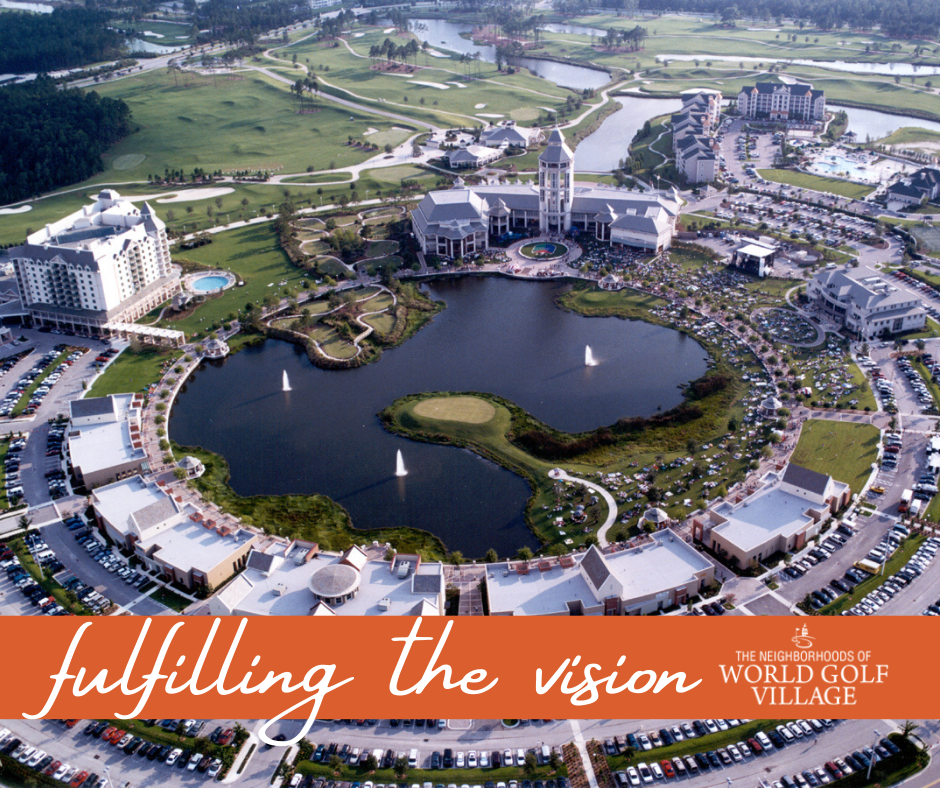
Behind anything great, you find a great story. World Golf Village is no exception. In the 1980s, St. Johns County had less than 100,000 residents. It was inevitable that the area would blossom with the right vision and execution. Jim Davidson, President of Davidson Development, was the man for the job.
Jim could see the pieces of the World Golf Village puzzle come together. “Not only could Jim see the Jacksonville market heading south and knew this was the perfect area between Jacksonville and St. Augustine, but he could see the pine trees becoming the development he envisioned,” shared Davidson Realty President and Jim’s wife, Sherry Davidson. “Jim saw beyond the golf courses, lakes, and homes and saw people walking their dogs and pushing their children in strollers on the sidewalks.”
Jim was persistent in bringing World Golf Village to life. He met regularly with land planners, engineers, attorney’s and an environmental team to make sure the pieces came together as he planned. Although many along the way didn’t believe, Jim never doubted he could get the job done right. Once the World Golf Village developer financed a new interchange on Interstate 95, the development became extremely attractive to commuters, as World Golf Village was one of only a few options for buyers in St. Johns County who worked in Jacksonville.
The pieces continued to come together after Jim brought the PGA TOUR and other golf organizations on board to build the World Golf Hall of Fame. From there, Jim assembled various partners for the golf courses, the hotel, and the retail stores to further bring attraction to the area. World Golf Village turned out to be exactly what people were looking for, including the Davidsons. Jim and Sherry Davidson were one of the first homeowners in World Golf Village and still live in World Golf Village to this day.
While building World Golf Village, the Davidsons worked hard to protect the environment to ensure the community maintained its natural beauty. More than 2,775 acres, nearly half of the project site, was set aside for preservation. These efforts were recognized by the Florida Association of Realtors ® when the Davidsons received the ENVY award in 2002. The ENVY award honor is given to developments that preserve Florida’s natural quality of life.
The infrastructure added by World Golf Village paved the way for the development of other communities in the area like The Hutson Companies’ SilverLeaf, which will have 10,700 homesites, 2,650,000 square feet of mixed-use commercial space, and more than 3,500 acres of conservation land. It is clear that World Golf Village blazed the trail.
The master planned community has prospered over the last 23 years and is regarded as one of the most desired communities on the First Coast. With more than 6,000 homes and more than 15,000 residents, World Golf Village provides a place to live that is picture perfect. Whether you are a golf lover eager to take advantage of the award winning golf courses or a family wanting to give their children the opportunity to attend fantastic public schools or interested in enjoying an active adult community, you have a home in World Golf Village.
World Golf Village has a vibrant history to be proud of and a legacy to look forward to, as it continues to be a highly sought-after area. No one knows World Golf Village better than Davidson Realty. If you are interested in calling World Golf Village home, contact Davidson Realty at (904) 940-5000.

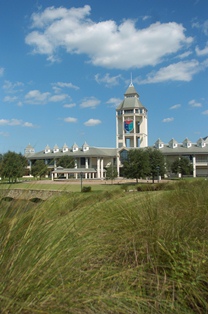 As previously mentioned, the formal closing of the WGV Partners and related start date was in August, 1996. The projected first phase costs were in excess of $350,000,000 and included the following:
As previously mentioned, the formal closing of the WGV Partners and related start date was in August, 1996. The projected first phase costs were in excess of $350,000,000 and included the following: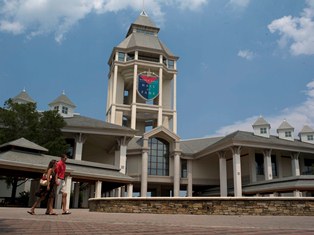 After the name and concept had been determined, all that was left to do was find a hotelier, a timeshare developer, a retail developer, a golf course developer and a group of builders who would buy into the
After the name and concept had been determined, all that was left to do was find a hotelier, a timeshare developer, a retail developer, a golf course developer and a group of builders who would buy into the 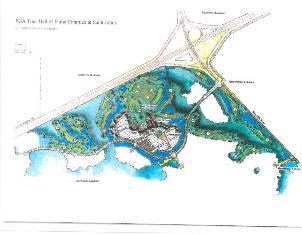 Once Deane Beman made the decision to locate the PGA TOUR Hall of Fame at the Saint Johns project, the specific details of the project components needed to be formalized. The original PGA TOUR Hall of Fame project concept was relatively small in terms of required development acreage with only one 18-hole golf course, a 350 resort room hotel and the 28,000 sq.ft. PGA TOUR Hall of Fame. The permitted Hall of Fame development area in the Saint Johns project was 82.0 acres, substantially more acreage than was required for the PGA Hall of Fame and a 350 room resort hotel. In addition, while the project concept had been decided upon, the source and amount of funding required for initial construction and future operations had not been identified.
Once Deane Beman made the decision to locate the PGA TOUR Hall of Fame at the Saint Johns project, the specific details of the project components needed to be formalized. The original PGA TOUR Hall of Fame project concept was relatively small in terms of required development acreage with only one 18-hole golf course, a 350 resort room hotel and the 28,000 sq.ft. PGA TOUR Hall of Fame. The permitted Hall of Fame development area in the Saint Johns project was 82.0 acres, substantially more acreage than was required for the PGA Hall of Fame and a 350 room resort hotel. In addition, while the project concept had been decided upon, the source and amount of funding required for initial construction and future operations had not been identified. 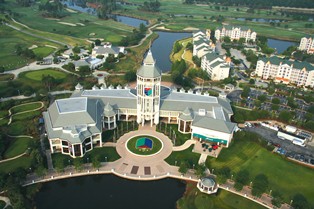 As previously discussed, “St. Johns Harbour” was permitted in 1986 with no specific development concept in mind other than lots of development rights on lots of acres. From 1986 until 1991, the project evolved into a resort oriented community anchored by the proposed PGA TOUR Hall of Fame. The PGA TOUR Hall of Fame was conceived by the then Commissioner of the PGA TOUR – Mr. Deane Beman. In 1990, Deane decided it was time for the TOUR to have its own Hall of Fame. The PGA of America had its Hall of Fame in Pinehurst, NC. With the TOUR’s headquarters in Ponte Vedra Beach, FL., Deane decided the TOUR’s Hall of Fame facility needed to be located somewhere in the First Coast area (preferably south of Jacksonville, FL). The reasoning was quite simple: 1) The proximity to PGA TOUR headquarters would facilitate project management. 2) Being south of Jacksonville on I-95 would capture all of the I-95/I-10/I-295 tourist traffic destined for South Florida. 3) Locating in the city of Jacksonville would provide an opportunity to solicit governmental financial support due to the project’s anticipated impact on local tourism.
As previously discussed, “St. Johns Harbour” was permitted in 1986 with no specific development concept in mind other than lots of development rights on lots of acres. From 1986 until 1991, the project evolved into a resort oriented community anchored by the proposed PGA TOUR Hall of Fame. The PGA TOUR Hall of Fame was conceived by the then Commissioner of the PGA TOUR – Mr. Deane Beman. In 1990, Deane decided it was time for the TOUR to have its own Hall of Fame. The PGA of America had its Hall of Fame in Pinehurst, NC. With the TOUR’s headquarters in Ponte Vedra Beach, FL., Deane decided the TOUR’s Hall of Fame facility needed to be located somewhere in the First Coast area (preferably south of Jacksonville, FL). The reasoning was quite simple: 1) The proximity to PGA TOUR headquarters would facilitate project management. 2) Being south of Jacksonville on I-95 would capture all of the I-95/I-10/I-295 tourist traffic destined for South Florida. 3) Locating in the city of Jacksonville would provide an opportunity to solicit governmental financial support due to the project’s anticipated impact on local tourism. 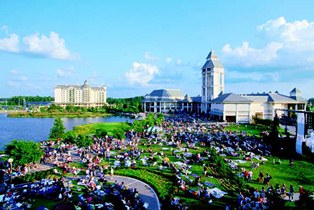 Despite taking over two (2) years to complete and costing $3.5 million, the Modification of Development Approvals and Environmental Permitting process experience was not that bad. Involved in the process were St. Johns County (SJC), Northeast Florida Regional Planning Council (NEFRPC) and the State of Florida – Department of Community Affairs (DCA). The DCA also coordinates with other state agencies such as the Florida Department of Transportation (FDOT).
Despite taking over two (2) years to complete and costing $3.5 million, the Modification of Development Approvals and Environmental Permitting process experience was not that bad. Involved in the process were St. Johns County (SJC), Northeast Florida Regional Planning Council (NEFRPC) and the State of Florida – Department of Community Affairs (DCA). The DCA also coordinates with other state agencies such as the Florida Department of Transportation (FDOT).  As previously indicated, there were 1,300 acres of land that had been included in the project approval process, but not acquired by the investors. Since almost 100% of the property to be acquired was adjoining the proposed interchange, the land acquisitions required for development also included acreage to construct the new interchange. A clover-leaf design interchange needs approximately 100 acres to be constructed and would encompass 80± acres upon completion. Once the ownerships were determined and title issues identified, the acquisition effort began. All of the land owners were well aware of the “increased” value of their property as permitted. It is clearly an understatement to say that it was unfortunate that the land was not put under contract prior to being permitted. Previously discussed verbal understandings of value didn’t mean much once the permits were issued. As such, the negotiations were extremely difficult. Fortunately many of the landowners had substantial additional acreage in proximity to the required acquisition acreage. Therefore, it was clearly in their best interest to see the project built for their future land values. Acreage acquisitions were as small as 7.1 acres up to over 1,000 acres.
As previously indicated, there were 1,300 acres of land that had been included in the project approval process, but not acquired by the investors. Since almost 100% of the property to be acquired was adjoining the proposed interchange, the land acquisitions required for development also included acreage to construct the new interchange. A clover-leaf design interchange needs approximately 100 acres to be constructed and would encompass 80± acres upon completion. Once the ownerships were determined and title issues identified, the acquisition effort began. All of the land owners were well aware of the “increased” value of their property as permitted. It is clearly an understatement to say that it was unfortunate that the land was not put under contract prior to being permitted. Previously discussed verbal understandings of value didn’t mean much once the permits were issued. As such, the negotiations were extremely difficult. Fortunately many of the landowners had substantial additional acreage in proximity to the required acquisition acreage. Therefore, it was clearly in their best interest to see the project built for their future land values. Acreage acquisitions were as small as 7.1 acres up to over 1,000 acres. 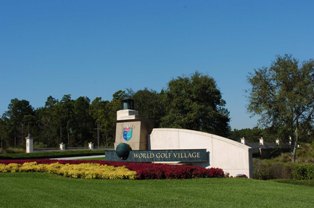 A month after our meeting in New York we met with the investors in Memphis to present our findings and recommendations. Since our previous meeting, we had completed an extensive review of the following project files:
A month after our meeting in New York we met with the investors in Memphis to present our findings and recommendations. Since our previous meeting, we had completed an extensive review of the following project files: Conceptually, the St. Johns’ Harbour project, as approved had, few attributes. Fortunately, the project did have significant exposure to I-95 and the granted approvals preceded the implementation of the 1985 Growth Management Act/Concurrency in St. Johns County, which implied the project would be vested from this yet to be implemented law. Finding a way to capitalize on these two project “attributes” was going to be the key to meeting the investor’s goals and objectives.
Conceptually, the St. Johns’ Harbour project, as approved had, few attributes. Fortunately, the project did have significant exposure to I-95 and the granted approvals preceded the implementation of the 1985 Growth Management Act/Concurrency in St. Johns County, which implied the project would be vested from this yet to be implemented law. Finding a way to capitalize on these two project “attributes” was going to be the key to meeting the investor’s goals and objectives. 





